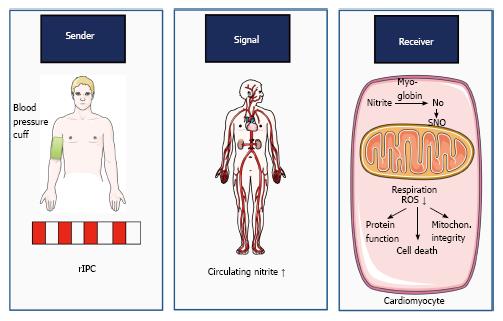Copyright
©The Author(s) 2015.
World J Cardiol. Oct 26, 2015; 7(10): 645-651
Published online Oct 26, 2015. doi: 10.4330/wjc.v7.i10.645
Published online Oct 26, 2015. doi: 10.4330/wjc.v7.i10.645
Figure 1 Nitrite/nitrogen oxides related signaling in remote ischemic preconditioning - proposed mechanism.
The nitrite/NO signaling involves three components. The sender of the signal is shown in the left panel. In this case the upper extremity receiving rIPC via repetitive in-/deflations of a blood pressure cuff. During this maneuver, the classical L-arginine-NOS-nitrogen oxides (NO) pathway is activated. This includes the activation of eNOS, which generates NO from l-arginine while using several cofactors. Off note, the eNOS system is under tight control of several systems, e.g., the calcium-calmodulin pathway. The middle panel represents the signal transmitted from the sender (remote organ) to the receiver (cardiomyocytes), as nitrite is transmitted from the site of generation via the circulation to the heart. In the receiving target organ, this signal is translated into cardioprotection via myoglobin-dependent nitrite reduction and S-nitrosation of mitochondrial complex I with a protective regulation of mitochondrial functions and reduced reactive oxygen species (ROS). The generation of NO in the last panel activates the alternative pathway for NO generation, which reduces nitrite to NO via hemeglobins, e.g., myoglobin in the heart or hemoglobin in the circulation. The reduction of ROS in turn may help reduce cellular stress as indicated. This relates to an improvement of protein function, cell death and mitochondrial integrity[8]. rIPC: Remote ischemic preconditioning; NOS: NO synthase.
- Citation: Totzeck M, Hendgen-Cotta U, Rassaf T. Concepts of hypoxic NO signaling in remote ischemic preconditioning. World J Cardiol 2015; 7(10): 645-651
- URL: https://www.wjgnet.com/1949-8462/full/v7/i10/645.htm
- DOI: https://dx.doi.org/10.4330/wjc.v7.i10.645









